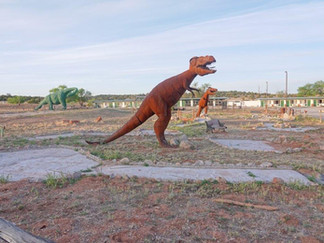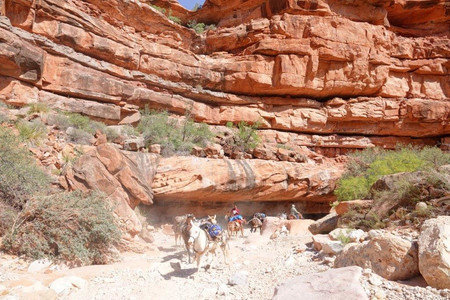40 Miles to Paradise: A Havasupai Adventure
- Ruth Bergman

- Jun 25
- 12 min read
Four Days in a Hidden Waterfall Oasis and a Secret Village
Many years ago, my good friend Pam—an Arizona local with a deep love of the desert—told me, “You have to go to Havasupai.” She spoke about it like a secret too sacred to keep, a place tucked away at the bottom of the Grand Canyon where red rock meets turquoise water, where a remote village still lives in harmony with the land. At the time, it felt impossibly far, both physically and logistically. But I never forgot the name.
Havasupai is a remote canyon system deep in the Havasupai Indian Reservation in northern Arizona. It’s home to the Havasupai Tribe and some of the most beautiful waterfalls in the world—cascades of mineral-rich water that glow an unreal shade of blue-green as they spill over deep orange travertine cliffs. The contrast between arid canyon walls and lush, spring-fed pools makes it feel like a hidden resort—untouched and wild, yet somehow serene and indulgent.
This year, Oren and I are living in San Diego, and for the first time, a trip to Havasupai became not just possible, but practical. The permit gods smiled on us, and we began to plan a four-day, three-night hiking and camping trip into this secluded world—one that lives up to every bit of its myth.
The photos below show just a glimpse of what makes Havasupai so extraordinary: towering red canyon walls framing a narrow oasis, waterfalls that seem painted onto the landscape, and ribbons of water tumbling down into impossibly clear pools. But photos can only do so much. To really understand Havasupai, you have to walk the miles and feel it surround you.
Before the Falls: Permits, Prices, and Prep
It seems the secret is out—Havasupai is no longer just a whispered recommendation from desert insiders. With its surreal waterfalls, blue-green pools, and canyon solitude, it’s become one of the most coveted wilderness destinations in the Southwest. Permits are now hard to come by, and planning ahead is essential.
All reservations are managed through havasupaireservations.com, and the process is entirely online. Permits for 2025 opened on February 1, with a required minimum stay of three nights and a total cost of $455 per person. Everything—including camping, access, and taxes—is bundled into that fee.
In December, I learned about a pre-sale lottery, which allows you to enter your desired dates ahead of the general release for a $20 per person fee (non-refundable and not applied to the permit cost). I signed up on December 17, submitting a request for four people—hoping some friends might join us. On January 6, I found out our request had been granted for May 27–30, 2025. The trip was on!
As it turned out, our friends couldn’t make it, and I was left with extra spots. Havasupai’s system requires you to purchase the entire reservation as requested, but fortunately, they offer a way to return unused spots to a shared pool. Within days, my extra permits were picked up by another group, and I was reimbursed (minus a 10% fee). The process was seamless, if pricey.
We left San Diego on May 26 and drove to the Grand Canyon Caverns Inn, where check-in for Havasupai now takes place. You can check in the night before your hike, and the process was incredibly smooth and well organized—a welcome surprise after such a long drive.
The Caverns Inn itself is a place stuck in time—a 1960s throwback full of strange charm. The caverns were closed when we visited, but we still got the full experience: a classic diner dinner and a sunset stroll past life-size dinosaur statues grazing on desert grass. It was odd, kitschy, and oddly perfect—one final moment of roadside Americana before disappearing into the wild.
Down the Red Wall
We woke at 5:00 a.m., joining the quiet procession of early risers making their way toward the canyon before the desert heat set in. By the time I stepped into the parking lot at 5:15, two-thirds of the cars were already gone—a reminder that in the Arizona desert, early starts aren’t optional, they’re survival.
After a simple hotel breakfast, we set off on the 1 hour and 15 minute drive to the Hualapai Hilltop trailhead. The route winds through tribal land, with stunning desert scenery along the way—dusty ridges glowing gold in the early light. We passed a few grazing cows and even a lone deer, reminders that this is still a wild and open landscape.
By the time we arrived, the trailhead parking was full. We found a spot about a kilometer away, shouldered our backpacks, and walked to the edge of the canyon. Below us stretched ten miles of trail, disappearing into the shadows of the red rock.
The descent begins abruptly, with a steep series of switchbacks that cut into the cliff for nearly two miles. After that, the trail is less steep, but continues to descend before dropping into a narrow canyon wash, where a wooden sign points one way to Supai and the other back to Hilltop. Here, the landscape changes—tall walls of red Supai sandstone rise around us, and the path becomes a long, gradual descent over packed sand and rock.
The trail is beautiful, even stark in places, with sheer cliffs and layered canyon walls that seem to glow from within. Knowing the geology now, I can see it in the photos—the red Supai formation above, and the Redwall limestone below. We were passed occasionally by other hikers, most of them coming up—people who had likely started even earlier than we had. Later, we saw mules making their way up and down the trail, carrying gear for those who had opted to carry less.
After about two hours, we began to see signs of water—small pools and green vegetation tucked between canyon walls. Another hour brought us to the edge of Supai Village, where we crossed the stream several times. Elderly residents passed us, offering polite hellos. The “No Photography” signs are a firm but respectful reminder: we are guests here, on Havasupai land.
We stopped at the village store for a cold drink and a quick chat with a fellow camper who offered tips on the best campsites. Re-energized, we continued down the trail, and soon the sound of roaring water signaled our arrival at Navajo Falls. We paused to admire it from above—our first glimpse of the famous blue-green water.
Just fifteen minutes later, we reached the crown jewel: Havasu Falls. I had seen countless photos of it, but nothing prepares you for the real thing. A rushing veil of water plunges over travertine rock, framed by red canyon walls, into a pool of vivid turquoise. It’s almost unreal—a waterfall that belongs in a dream.
Still, we needed to claim a campsite, so we pressed on. Taking advice from the camper we met in Supai, we continued to the far end of the campground and found a shaded spot near Mooney Falls. We set up camp, changed into bathing suits, and retraced our steps to Havasu Falls with our camp chairs in tow.
That afternoon, we sat in the cool water and let the fatigue melt away, surrounded by the rush of the falls and the stillness of the canyon. After ten miles on foot, we had earned it—and the place welcomed us.
Where Rivers Meet: The Confluence Hike
Somewhere on the hike down to the campground, we made a decision: we’d tackle the Confluence hike the very next day, leaving ourselves a full day to rest before the climb back out. With our campsite near Mooney Falls, we were as close as possible to the start of the trail—but it would still be an 18-mile round trip. Long, but doable.
We woke again at 5:00 a.m., made coffee in the half-light, and set off a little after 6:00. Within minutes we stood at the top of Mooney Falls, facing a weathered wooden sign that read: “Descend at Your Own Risk.”
It took a moment to locate the trail—a hole in the rock wall, leading to a vertigo-defying descent known among hikers as “shoots and ladders.” Somehow, despite my usual discomfort with heights, I didn’t hesitate. The trail clings to the cliff face, using chains, ladders, and worn footholds to guide you through slippery rock. It’s a four-limb climb, and kind hikers leave behind gloves to help with the wet metal rungs. Surprisingly, I felt focused and steady. Maybe determined is the better word.
At the bottom, Mooney Falls thunders into the canyon, spray hanging in the air like mist. It was still early, and the water was freezing. As gorgeous as the scene was, we didn’t linger—there were many miles ahead.
The hike itself is less difficult than it is long and intricate. The trail hugs the edge of Havasu Creek, requiring multiple river crossings—three before Beaver Falls, and eight more before the Confluence. I kept notes on their locations for an appendix, but truthfully, they shift with each flood and season.
We switched between hiking shoes and water shoes, trying to stay dry and nimble, but it was a losing game. About halfway in, the sole of one of my Keens peeled off completely. I surrendered and waded across in my hiking boots—they were nearly dead anyway. In the morning, the water was cold and bracing; by afternoon, it felt like relief.
Still, all the soaking and scrambling was worth it. This may be the most beautiful day hike I’ve ever done. The turquoise creek flows continuously, breaking into cascades and pools as we moved deeper into the canyon. Red rock walls towered above us, and the trail darted from one side of the creek to the other whenever the canyon walls dropped straight into water.
There were moments of quiet magic: bighorn sheep grazing just feet from the trail, calm and unbothered by our presence. The lush, stepped pools of Beaver Falls, begging for a swim. And finally, the grand finale: the Confluence, where the clear, mineral-blue of Havasu Creek pours into the deep green of the Colorado River.
From above, the canyon narrows into a tight slot, then opens suddenly at the confluence. After hours of following the creek through red rock and turquoise pools, we had arrived—the Grand Canyon. A group of rafters was pulled up along the bank, their boats tied below. We joined them for a quick swim and a snack, grateful for the cold water and the moment to rest.
The trail was mostly easy to follow, though we briefly lost it near a rock opening on the way out, and again later when we missed a crossing and ended up scrambling up a precarious slope of red rock. At that point, it had been a long day. A very long day.
We returned to camp at 6:00 p.m., exhausted but exultant. Legs aching, shoes soaked, minds completely full. There’s something incredibly satisfying about a hike that asks for everything you have—and then gives it all back in beauty.
Waterfall Day: A Natural Resort
This was our rest day, and we embraced it fully. No alarms, no agenda—just the promise of waterfalls and warm sun. We woke up naturally, made a slow breakfast, and lingered at camp. With the desert heating up fast by late morning, it made sense to save the swimming for the hottest part of the day.
Our first stop was Fifty Foot Falls. To reach it, we had to wade through the creek—a refreshing start to the day. The falls are wide and graceful, spilling over vegetation-covered travertine formations, with the ever-present red rock canyon rising behind. A large, waist-deep pool collects at the base, creating a perfect swimming spot. We sat on warm rocks nearby, letting the rhythm of falling water ease us into the day.
When we got hungry, we walked up to Supai Village for lunch. Our decision was nudged along by an aggressive local—a fat, mean squirrel who had broken into our tent, eaten most of my trail mix, and run off with one of Oren’s bars. It even chewed a hole in the tent wall to steal a chocolate bar. While we weren’t in danger of starving, we took the hint and went to the store.
At the village, we passed the long line for helicopter rides out. It struck me then that Havasupai has become something of a luxury destination. With a baseline cost of $455 per person—plus the option to fly out by helicopter, send gear in by mule, and stay in the lodge—this place is accessible mainly to those willing to spend. I found myself estimating: based on the number of cars, I guessed about 500 campers, each paying roughly $150 per day. That’s $75,000 a day just from camping fees—not including meals, souvenirs, mules, or helicopter rides. It’s easy to imagine that in a few years, the village’s modest homes and cluttered yards might be replaced by villas with swimming pools. But we all do our own calculation, and this place is still worth it. Everyone should see it at least once.
After lunch, we returned to our self-designed waterfall tour. Our next stop was Navajo Falls, which is actually a series of falls. One side is made of gentle cascades and blue pools, and another section is a long veil of water that tumbles into a deeper basin. By now it was midday and blazing hot, so we jumped into the pool and let the water massage our shoulders under the falls. We set up our camp chairs, and sat listening to the constant roar and watching the light play through the mist. As the afternoon passed, other visitors left, and suddenly, this paradise was just ours.
Eventually, the heat sent us in search of more shade. We packed up and returned to Havasu Falls, which never gets old. The color of the water, the way it drops straight from a travertine ledge, the backdrop of towering canyon walls—it’s hard to stop looking at it. It’s the kind of place that feels too beautiful to be real, even when you're standing in it.
We ended the day with a cup of coffee at the top of Mooney Falls, watching the sun dip behind the cliffs and listening to the roar of water echo through the canyon. We’d hear it all night as we slept.
I can’t imagine a day better spent. If someone set out to design the perfect resort, with dramatic cliffs, pools of turquoise water, and endless natural beauty—they still couldn’t come close to the magic of this natural resort.
Climbing Back to the Rim
We woke up at 4:30 a.m., determined to beat the heat on the long hike out of the canyon. The night before, we’d walked the extra kilometer to fill water at the spring—great-tasting water, by the way—so we could pack quickly in the morning. By 5:30, coffee made, breakfast eaten, and bags strapped tight, we were on the trail.
We said a final goodbye to the towering cliffs that had sheltered our campsite, pausing for one last photo of Havasu Falls, still glowing in the soft morning light. We thought we’d gotten an early start—until we reached the beginning of the campground and saw all the backpacks lined up for mule pickup. Clearly, others had been up even earlier.
The first stretch of the hike was surprisingly pleasant. The sun hadn’t yet crested the canyon walls, and we walked in cool shade, following the gentle ascent through the wash. It felt pretty easy.
By 10:00 a.m., we were in full sun. The temperature climbed fast, and so did the canyon. I needed a break. From there, the hike turned into a slow, hot slog, the kind that tests your resolve. The last two miles up the switchbacks were the hardest. Our packs felt heavier with each step. We paused again for water and shade, offering tired smiles to the folks coming down—but conversation took more energy than we had to spare.
Still, two miles is only two miles, and eventually every climb ends. Just when we were questioning whether we were close, we rounded a switchback and saw the little bathroom hut that marks the Hilltop trailhead. It was somehow both unbelievable and completely ordinary.
We’d made it.
We still had one more kilometer to walk to the car, of course. But the promise of air conditioning and flip-flops pulled us the rest of the way.
From Blistered Feet to Blue Water Bliss
Havasupai is not an easy place to reach—and that’s part of what makes it so unforgettable. We hiked more than forty miles in four days, climbed chains down canyon walls, crossed cold rivers in wet boots, and baked under the sun with heavy packs on our backs. But in return, we got something rare: the chance to live inside beauty, not just observe it.
For four days, we moved between sweat and water, between effort and relief. One moment climbing a dusty trail, the next sinking into a pool so blue it looked dyed. Jumping in and out of waterfalls becomes a kind of rhythm—a baptism that washes away the fatigue, then returns it with every mile.
The physical challenge makes you slow down, makes you pay attention. And the place itself demands reverence. Towering red cliffs, roaring turquoise waterfalls, and deep canyon silence—all of it so striking, so alive, you begin to understand why Native American traditions assign spirit beings to these features. They feel more than natural. They feel sacred.
And though you might come for the views, it's the details you carry home: the worn gloves on the chain descent, a squirrel with a taste for chocolate, the way other hikers smile and nod as if we’re all part of some quiet pact. The last sip of spring water. Coffee with Mooney Falls roaring behind it. That final glimpse of Havasu as you turn back for the climb.
Now, back in the world of pavement and screens, I still find myself replaying it—a memory soaked in sunlight and cold water. My feet have healed, but that blue still lingers.
Hiking maps and stats
For some reason, the hike down into the canyon on May 27, was not uploaded from Oren's watch. However, it is the exact reverse of the hike to the rim.
Hike to rim, May 30, 17km, 769m elevation gain, 4hrs 21 min.
Hike to confluence, May 27, 28.6km, 668m elevation gain, 8hrs.
Stream crossing points are listed in the table below. Streams crossings change over time
Stream Crossing Distance (km) Notes
From Mooney Falls
1 2.07
2 2.3
3 4.07 Two successive crossings, then Arrive Beaver Falls
4 5.47
5 6.25 Two crossings
6 7.13
7 8.0
8 8.43
9 12 Waist deep crossing
10 12.3
11 12.7 Arrive Confluence
Resources
Havasupai Reservations https://www.havasupaireservations.com/
Grand Canyon Caverns Inn https://gccaverns.com/the-caverns-inn
The Adventure Diet, Epic 4 Day Havasupai Falls itinerary for adventure lovers , I used this itinerary to plan our trip, and it's a good alternative to hike to Beaver Falls if the hike to the Confluence feels too ambitious.






































































Comments